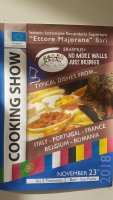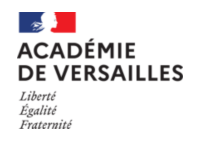
ERASMUS + No more walls just bridges - 1th meeting in Bari - November 19-23 2018
IISS "Majorana" hosted in Bari the first meeting of the project from 18th to 24th November 2018.
The partners from France, Belgium, Portugal, Romania arrived on Sunday18th November.
The works started on Monday 19 November at the main building of the school. During the welcome ceremony the partners introduced their schools and countries and played a kahoot game to vote the winner of the logo competition to choose the official logo of the project.
Later the students took part to art workshops about healthy/ junk food and habits: Prof. Mazzarino run a photo- editing workshop where the students created funny creatures mixing animals and vegetables; other students chose to work with prof. Poletto and drew and coloured posters on healthy/ bad food and habits. The students who worked with prof. Vitarella created posters with the collage technique inventing healthy and junk “foodscapes” inhabited by elves and ogres.
Contemporarily the teachers ‘meeting took place in the Palese building. Later the teachers visited the school guided by some Italian colleagues who showed them the facility.
At 13.30 all the participants took a guided tour to the Petruzzelli theatre, a symbol of both Italian musical excellence and architectural beauty. It is the fourth largest theatre in Italy, and the largest private one in Europe. It re-opened in 2009, eighteen years after the fire that destroyed it in 1991.
Then the students took part to an orienteering experience in the city centre organized by their Italian mates. In the meanwhile the Italian teachers guided their foreign colleagues in the labyrinthine alleys of Bari showing them the most famous monuments of the city and speaking about the historical and urban development of the city.
On Tuesday morning, 20th November, the participants visited the famous Castellana caves. They went on a 3 km guided tour to a unique speleological complex formed about 90 million years ago that is one of the most important attractions of Puglia and a natural heritage. It has an inestimable value for Italy.
In the afternoon they visited the UNESCO site of Alberobello and its famous “TRULLI”, limestone dwellings built with a prehistoric technique.
Upon their return at school, students and teachers had a dinner all together.
On Wednesday morning, 21st November, the participants visited a didactic oil mill in Bitonto. There they learnt how to produce organic olive oil. Puglia produces more olive oil than any other Italian region, the oil from the area of Bitonto is famous because it’s closer in character to the taste of fresh olives, with a slight almond taste.
The morning ended with the rehearsal for the cooking show.
After the lunch at school, the students completed their art works while their teachers attended another meeting.
The day ended with a dancing dinner in the auditorium of the school where the Italian students and their parents organized a buffet. A DJ set organized by the Italian students lived up the party.
On Thursday 22nd November the group went to Matera, that is a UNESCO place and the European capital of culture 2019.
Matera is the most outstanding, intact example of a troglodyte settlement in the Mediterranean region, perfectly adapted to its terrain and ecosystem. Its settlements illustrate a number of significant stages in human history. People lived for centuries in the caves of which the city is rich, and transformed them in dwellings.
The trip started with a visit to CASA NOHA, which is an example of the residential architecture of the Sassi. It is made of tufa walls and vaulted ceilings were the video “The invisible Sassi is projected. It represents an extraordinary journey through the history of Matera” by Giovanni Carrada. The images tell the visitors the history of the city from its origins to the present day.
The trip continued with a visit to the Roman cathedral and a walk in the ancient alleys where is set an exhibition of surrealistic sculptures of Salvator Dalì, “The Persistence of Opposites”, a museum path showing the main conceptual dualisms of Dali’s art. After the walk, the partecipants had a lunch in a typical restaurant located in an ancient oil mill.
In the evening the students went to an Escape Room where they solved puzzles and riddles using clues, hints, and strategy to complete their objectives. It was an enjoyable challenge and an opportunity to improve linguistic and cultural competences and abilities.
On Friday 23rd November there was a Cooking competition and each country prepared its typical dishes. Under the supervision of the cooking teachers, they prepared starters, main dishes and desserts. It was very interesting because the participants realized that some foods are common all over Europe: they prepared dishes matching mussels and potatoes with Apulian and Belgian recipes, several regional variations of stewed meat, an almost universal rice pudding and other tasty dishes. Few things connect us to a country better than local food and few things connect people better than food. Thus the winner, at the end, was…Europe!
The Italian students attending courses for waiters served at lunch the European delicatessen and there was a lot of fun. In the lobby of the restaurant, teachers and students viewed the exhibition of the art works produced in the workshops.
After a free afternoon and some shopping in the city centre, the participants met in a restaurant for a salutation dinner and tasted “panzerotti”, an Apulian domestic poor food whose origins are lost in the mists of time. Those pieces of dough, stuffed with different filling and fried in very hot olive oil, are among the most famous and tasty Apulian specialities and has become a popular street food for tourists and citizens.
On Saturday 6th April the guests departed accompanied by the Italian hosts.

